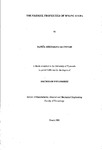THE FATIGUE PROPERTIES OF SPRING STEEL
| dc.contributor.author | HATTINGH, DANIEL GERHARDUS | |
| dc.contributor.other | School of Engineering, Computing and Mathematics | en_US |
| dc.date.accessioned | 2013-10-23T08:45:30Z | |
| dc.date.available | 2013-10-23T08:45:30Z | |
| dc.date.issued | 1998 | |
| dc.identifier | NOT AVAILABLE | en_US |
| dc.identifier.uri | http://hdl.handle.net/10026.1/2300 | |
| dc.description.abstract |
The nature and scope of this thesis can be divided into three categories, namely stress distribution modelling in coil springs; fatigue and failure analysis, an investigation into measurement of residual stresses and the relation to fatigue life. The operation of springs is directly concerned with the theories of torsion and bending which makes the better understanding of these theories essential. The first part of the thesis is involved with a mathematical evaluation of these theories and a case study of an isolated loop of a coil spring. The mathematical modelling is verified by measuring the strain levels in a coil spring with the aid of strain gauges located at different positions in the coil spring. This evaluation gave a better understanding of the operational stress distribution for input into the two methods currently used by industry for the fatigue testing, namely isolated loop and complete coil spring samples. The remaining part of the thesis revolves around the understanding of the relationship between fatigue life, process effects and residual stresses. The relationship between fatigue failures and process effects was investigated to reveal the mechanism responsible for component fatigue failure in a 55Cr3 automotive suspension spring steel. This was done by subjecting coil springs, withdrawn from different stages of the manufacturing process, to fatigue tests, ensuring that all possible sources of fatigue initiation in this material batch have been identified, including those not dominant in the finished component. Failures prior to shot peen process was mainly surface relate as where those withdrawn after this process were subsurface (inclusions) related. Fractographic analysis, using an XL30 scanning electron microscope, has revealed a number of sources of initiation, which are largely related to mechanical damage and inherent material defects. The results indicate that decreasing defect levels in the material would represent a valid method for enhancing the fatigue response, specifically levels of nonmetallic inclusions and surface mechanical damage, but also that certain manufacturing process stages (cold scragg) are responsible for drop in fatigue life. | en_US |
| dc.language.iso | en | en_US |
| dc.publisher | University of Plymouth | en_US |
| dc.title | THE FATIGUE PROPERTIES OF SPRING STEEL | en_US |
| dc.type | Thesis | |
| dc.identifier.doi | http://dx.doi.org/10.24382/1609 | |
| dc.identifier.doi | http://dx.doi.org/10.24382/1609 |
Files in this item
This item appears in the following Collection(s)
-
01 Research Theses Main Collection
Research Theses Main


